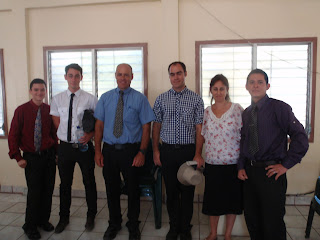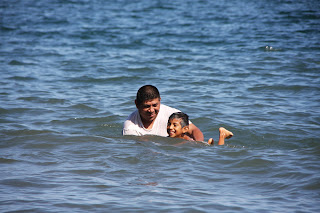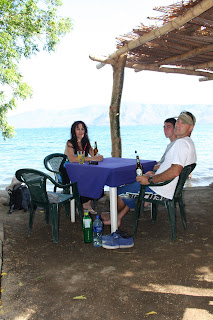GRANADA
Today we got up bright and early and headed out to find a bus to Granada so that we could visit the English congregation there and explore the town.
Hardly anyone uses street names here and maps seem non-existent, so if you ask for directions you usually get told something like "oh so many blocks in this direction and then you should see this land mark and then you turn right and walk one and a half blocks and then turn left and then it's another so many blocks from there". Not always easy to follow especially if you're a fair walk away and lots of twists and turns are needed to get to your destination, so what I've been doing is asking someone and paying really close attention to the first 5 or so instructions and then we we make it that far, then I find someone else and get the next set of directions - it seems to be working :)
Hardly anyone uses street names here and maps seem non-existent, so if you ask for directions you usually get told something like "oh so many blocks in this direction and then you should see this land mark and then you turn right and walk one and a half blocks and then turn left and then it's another so many blocks from there". Not always easy to follow especially if you're a fair walk away and lots of twists and turns are needed to get to your destination, so what I've been doing is asking someone and paying really close attention to the first 5 or so instructions and then we we make it that far, then I find someone else and get the next set of directions - it seems to be working :)
So we found the right spot, out on the main highway, people are very friendly and helpful - luckily I checked with a young guy to make sure that we were at the right spot to catch the Granada bus when we arrived because when the right bus came along he pointed it out to us. Without his help we may have missed it because it was a little navy and white micro bus and I was looking out for a proper sized multicoloured bus, they just seem like so much more fun!
The mini bus was pretty full but not too crowded.
Granada isn't too far away from Masaya so after about a 15 min walk from the hostel and a 25 min bus trip we got off at the stop that one of our new friends, Wilfredo, had told us was the closest one to the hall. A 5 min walk had us outside of the hall but we had lots of time up our sleeve so we wandered around for a bit looking for a panaderia for some breakfast (bakery) - it turned out that there was one right next to where we'd jumped off the bus so after a bit of back tracking we got our breakfast.
Then it was back to the hall where we met lots of lovely brothers and sisters. Many were from America, Chicago area mainly, but there were a few other nationalities and some local Nicaraguan brothers and sisters learning English too.
A visiting brother from England gave a lovely talk on how love can cover the imperfections of others - he said that the imperfections of others are like rising damp in England. Rising damp just keeps coming through and there's nothing that can be done other than to keep painting over it - so when the imperfections of others keep coming through, rather than letting them bother us too much, or reacting badly, we should paint over them with love so we don't focus on them and instead enjoy their good qualities. Nice illustration.
We got to catch up with Alex who we met in the Masaya Spanish congregation last week (a young bro keenly learning English) and with Frank, a lovely young brother who we'd met on Face Book before we arrived.
After the meeting we headed into town to have a look around and find some lunch.
There are lots of lovely buildings in Granada and a lot of them beautifully painted and much better cared for than those in Masaya.
Granada was founded in 1524 by Francisco Hernández de Córdoba and over the years it has seen and experienced a number of battles with English, French and Dutch pirates all trying to take over Nicaragua at different times in history.
There is some beautiful architecture here that is said to reflect Moorish and Andalusian appearance more than the Castillian style seen in León.
There are some great statues ....
... and lots of horses and carriage, both of which seem much better cared for than the ones we had seen in Masaya.
For a change we were hungry so we found a nice looking little cafe and enjoyed a lovely lunch there. The girl running the cafe spoke a little English and we had a few laughs with her as she took our order.
Granada is located along the coast of Lake Nicaragua and as it was a hot day we thought we'd walk down the malecón and have a swim. Sadly the beach is so dirty that we couldn't bring ourselves to swim there and instead took a little time out in the shade of the coconut trees on the foreshore.
Most of the way down the malecón (esplanade) is beautifully set out with paved streets, bright buildings, very inviting looking restaurants and bars and along the way we found a nice reminder of our lovely friends the Bohorquez family ....
.... the last quarter or so of the malecón is still under construction and turns to a dirt road.
After our little relax on the beach we found our way back to where the buses leave and took a minibus home. This time there were at one stage 30 people packed into the bus. We wondered if the operators ever turn anyone away when the bus is too full, it didn't seem so, still who can complain when a 25 minute trip costs .40c.




































































